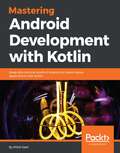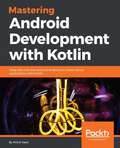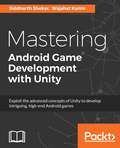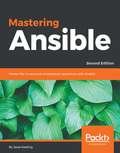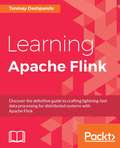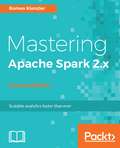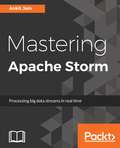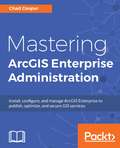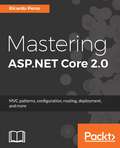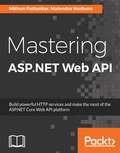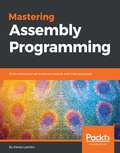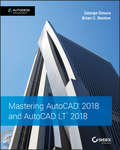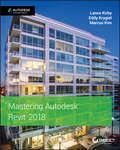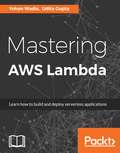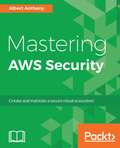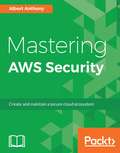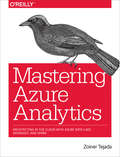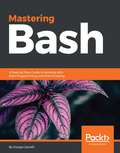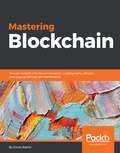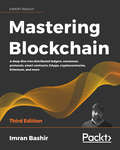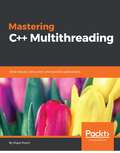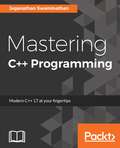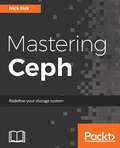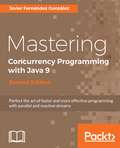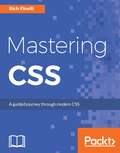- Table View
- List View
Mastering Android Development with Kotlin: Deep dive into the world of Android to create robust applications with Kotlin
by Milos VasicMaster Android development using a variety of Kotlin features About This Book • Leverage specific features of Kotlin to ease Android application development • An illustrative guide that will help you write code based Kotlin language to build robust Android applications • Filled with various practical examples build amazing Android project using Kotlin so you can easily apply your knowledge to real world scenarios Who This Book Is For The book is for developers who want to build amazing Android applications in an easy and effective way. Basic knowledge of Kotlin is assumed, but you do not need any familiarity with Android development. What You Will Learn • Understand the basics of Android development with Kotlin • Get to know the key concepts in Android development • See how to create modern mobile applications for the Android platform • Adjust your application's look and feel • Know how to persist and share application database • Work with Services and other concurrency mechanisms • Write effective tests • Migrate an existing Java-based project to Kotlin In Detail Kotlin is a programming language intended to be a better Java, and it's designed to be usable and readable across large teams with different levels of knowledge. As a language, it helps developers build amazing Android applications in an easy and effective way. This book begins by giving you a strong grasp of Kotlin's features in the context of Android development and its APIs. Moving on, you'll take steps toward building stunning applications for Android. The book will show you how to set up the environment, and the difficulty level will grow steadily with the applications covered in the upcoming chapters. Later on, the book will introduce you to the Android Studio IDE, which plays an integral role in Android development. We'll use Kotlin's basic programming concepts such as functions, lambdas, properties, object-oriented code, safety aspects, type parameterization, testing, and concurrency, which will guide you through writing Kotlin code into production. We'll also show you how to integrate Kotlin into any existing Android project. Style and approach In this book, you'll master Android development using Kotlin through real application examples. We'll introduce you to basic Android concepts and offer guidance from the first steps to the final project. In each chapter, we'll develop one important application functionality as a development milestone. As we progress, you'll become more experienced in Android and our application will progress toward a real-world product. Finally, when we complete the application's development, we'll write proper tests to ensure it's production ready.
Mastering Android Development with Kotlin
by Miloš VasićKotlin is a programming language intended to be a better Java, and it is designed to be usable and readable across large teams with different levels of knowledge. Kotlin gives more to Android than Java ever did. With this book, you will learn how to create effective and modern applications using a cutting edge programming language. We’ll teach you Android from novice to master level, and guide you to become an experienced Android developer
Mastering Android Game Development with Unity
by Siddharth Shekar Wajahat KarimCreate enthralling Android games with Unity Faster Than Ever Before About This Book • Develop complex Android games with the help of Unity's advanced features such as artificial intelligence, high-end physics, and GUI transformations. • Create amazing Graphical User Interfaces (GUIs) with Unity's new uGUI system • Unravel and deploy exciting games across Android devices Who This Book Is For If you are a Unity 5 developer and want to expand your knowledge of Unity 5 to create high-end complex Android games, then this book is for you. Readers are expected to have a basic understanding of Unity 5, working with its environment, and its basic concepts. What You Will Learn • Develop your own Jetpack Joyride clone game • Explore the advanced features of Unity 5 by building your own Action Fighting game • Develop remarkable Graphical User Interfaces (GUIs) with Unity's new uGUI system • Enhance your game by adding stunning particle systems and complex animations • Build pleasing virtual worlds with special effects, lights, sky cube maps, and cameras • Make your game more realistic by providing music and sound effects • Debug and deploy your games on different Android devices In Detail Game engines such as Unity are the power-tools behind the games we know and love. Unity is one of the most widely-used and best loved packages for game development and is used by everyone, from hobbyists to large studios, to create games and interactive experiences for the Web, desktop, mobile, and console. With Unity's intuitive, easy-to-learn toolset and this book, it's never been easier to become a game developer. You will begin with the basic concepts of Android game development, a brief history of Android games, the building blocks of Android games in Unity 5, and the basic flow of games. You will configure an empty project for the Jetpack Joyride Clone Game, add an environment and characters, and control them. Next you will walk through topics such as particle systems, camera management, prefabs, animations, triggers, colliders, and basic GUI systems. You will then cover the basic setup for 3D action fighting games, importing models, textures and controlling them with a virtual on-screen joystick. Later you will set up Scene for 3D Configuration, create basic gameplays, and manage input controls. Next you will learn to create the interface for the main menu, gameplay, game over, achievements, and high score screens. Finally you will polish your game with stats, sounds, and Social Networking, followed by testing the game on Android devices and then publishing it on Google Play, Amazon, and OUYA Stores. Style and approach A step-by-step and detailed guide to developing high-end complex Android games utilizing the advanced concepts of Unity.
Mastering Ansible - Second Edition
by Jesse KeatingMaster the ins and outs of advanced operations with Ansible About This Book • Learn how to extend Ansible with custom modules, plugins, and inventory sources • Utilize advanced Ansible features to orchestrate rolling updates with little to no service disruptions • An up-to-date book that brings to light the newly added features in Ansible 2.x Who This Book Is For This book is for Ansible developers and operators who have an understanding of the core elements and applications but are now looking to enhance their skills in applying automation using Ansible. What You Will Learn • Gain an in-depth understanding of how Ansible works under the covers • Fully automate the Ansible playbook executions with encrypted data • Access and manipulate variable data within playbooks • Use Blocks to construct failure recovery or cleanup • Explore the Playbook debugger and Ansible Console • Troubleshoot unexpected behavior effectively • Work with cloud infrastructure providers and container systems • Develop custom modules, plugins, and dynamic inventory sources In Detail This book provides you with the knowledge you need to understand how Ansible 2.1 works at a fundamental level and leverage its advanced capabilities. You'll learn how to encrypt Ansible content at rest and decrypt data at runtime. You will master the advanced features and capabilities required to tackle the complex automation challenges of today and beyond. You will gain detailed knowledge of Ansible workflows, explore use cases for advanced features, craft well thought out orchestrations, troubleshoot unexpected behaviour, and extend Ansible through customizations. Finally, you will discover the methods used to examine and debug Ansible operations, helping you to understand and resolve issues. By the end of the book, the readers will be able to unlock the true power of the Ansible automation engine and will tackle complex real world actions with ease. Style and approach This clear, practical guide illustrates the advanced functionalities of Ansible, its system architecture, and design aspects that will help you to master Ansible with ease.
Mastering Apache Flink
by Tanmay DeshpandeBig data developers who are looking to process batch and real-time data on distributed systems. Basic knowledge of Hadoop and big data is assumed. Reasonable knowledge of Java or Scala is expected.
Mastering Apache Spark 2.x - Second Edition
by Romeo KienzlerAdvanced analytics on your Big Data with latest Apache Spark 2.x About This Book • An advanced guide with a combination of instructions and practical examples to extend the most up-to date Spark functionalities. • Extend your data processing capabilities to process huge chunk of data in minimum time using advanced concepts in Spark. • Master the art of real-time processing with the help of Apache Spark 2.x Who This Book Is For If you are a developer with some experience with Spark and want to strengthen your knowledge of how to get around in the world of Spark, then this book is ideal for you. Basic knowledge of Linux, Hadoop and Spark is assumed. Reasonable knowledge of Scala is expected. What You Will Learn • Examine Advanced Machine Learning and DeepLearning with MLlib, SparkML, SystemML, H2O and DeepLearning4J • Study highly optimised unified batch and real-time data processing using SparkSQL and Structured Streaming • Evaluate large-scale Graph Processing and Analysis using GraphX and GraphFrames • Apply Apache Spark in Elastic deployments using Jupyter and Zeppelin Notebooks, Docker, Kubernetes and the IBM Cloud • Understand internal details of cost based optimizers used in Catalyst, SystemML and GraphFrames • Learn how specific parameter settings affect overall performance of an Apache Spark cluster • Leverage Scala, R and python for your data science projects In Detail Apache Spark is an in-memory cluster-based parallel processing system that provides a wide range of functionalities such as graph processing, machine learning, stream processing, and SQL. This book aims to take your knowledge of Spark to the next level by teaching you how to expand Spark's functionality and implement your data flows and machine/deep learning programs on top of the platform. The book commences with an overview of the Spark ecosystem. It will introduce you to Project Tungsten and Catalyst, two of the major advancements of Apache Spark 2.x. You will understand how memory management and binary processing, cache-aware computation, and code generation are used to speed things up dramatically. The book extends to show how to incorporate H20, SystemML, and Deeplearning4j for machine learning, and Jupyter Notebooks and Kubernetes/Docker for cloud-based Spark. During the course of the book, you will learn about the latest enhancements to Apache Spark 2.x, such as interactive querying of live data and unifying DataFrames and Datasets. You will also learn about the updates on the APIs and how DataFrames and Datasets affect SQL, machine learning, graph processing, and streaming. You will learn to use Spark as a big data operating system, understand how to implement advanced analytics on the new APIs, and explore how easy it is to use Spark in day-to-day tasks. Style and approach This book is an extensive guide to Apache Spark modules and tools and shows how Spark's functionality can be extended for real-time processing and storage with worked examples.
Mastering Apache Storm
by Ankit JainMaster the intricacies of Apache Storm and develop real-time stream processing applications with ease About This Book • Exploit the various real-time processing functionalities offered by Apache Storm such as parallelism, data partitioning, and more • Integrate Storm with other Big Data technologies like Hadoop, HBase, and Apache Kafka • An easy-to-understand guide to effortlessly create distributed applications with Storm Who This Book Is For If you are a Java developer who wants to enter into the world of real-time stream processing applications using Apache Storm, then this book is for you. No previous experience in Storm is required as this book starts from the basics. After finishing this book, you will be able to develop not-so-complex Storm applications. What You Will Learn • Understand the core concepts of Apache Storm and real-time processing • Follow the steps to deploy multiple nodes of Storm Cluster • Create Trident topologies to support various message-processing semantics • Make your cluster sharing effective using Storm scheduling • Integrate Apache Storm with other Big Data technologies such as Hadoop, HBase, Kafka, and more • Monitor the health of your Storm cluster In Detail Apache Storm is a real-time Big Data processing framework that processes large amounts of data reliably, guaranteeing that every message will be processed. Storm allows you to scale your data as it grows, making it an excellent platform to solve your big data problems. This extensive guide will help you understand right from the basics to the advanced topics of Storm. The book begins with a detailed introduction to real-time processing and where Storm fits in to solve these problems. You'll get an understanding of deploying Storm on clusters by writing a basic Storm Hello World example. Next we'll introduce you to Trident and you'll get a clear understanding of how you can develop and deploy a trident topology. We cover topics such as monitoring, Storm Parallelism, scheduler and log processing, in a very easy to understand manner. You will also learn how to integrate Storm with other well-known Big Data technologies such as HBase, Redis, Kafka, and Hadoop to realize the full potential of Storm. With real-world examples and clear explanations, this book will ensure you will have a thorough mastery of Apache Storm. You will be able to use this knowledge to develop efficient, distributed real-time applications to cater to your business needs. Style and approach This easy-to-follow guide is full of examples and real-world applications to help you get an in-depth understanding of Apache Storm. This book covers the basics thoroughly and also delves into the intermediate and slightly advanced concepts of application development with Apache Storm.
Mastering ArcGIS Enterprise Administration
by Chad CooperLearn how to confidently install, configure, secure, and fully utilize your ArcGIS Enterprise system. About This Book • Install and configure the components of ArcGIS Enterprise to meet your organization's requirements • Administer all aspects of ArcGIS Enterprise through user interfaces and APIs • Optimize and Secure ArcGIS Enterprise to make it run efficiently and effectively Who This Book Is For This book will be geared toward senior GIS analysts, GIS managers, GIS administrators, DBAs, GIS architects, and GIS engineers that need to install, configure, and administer ArcGIS Enterprise 10.5.1. What You Will Learn • Effectively install and configure ArcGIS Enterprise, including the Enterprise geodatabase, ArcGIS Server, and Portal for ArcGIS • Incorporate different methodologies to manage and publish services • Utilize the security methods available in ArcGIS Enterprise • Use Python and Python libraries from Esri to automate administrative tasks • Identify the common pitfalls and errors to get your system back up and running quickly from an outage In Detail ArcGIS Enterprise, the next evolution of the ArcGIS Server product line, is a full-featured mapping and analytics platform. It includes a powerful GIS web services server and a dedicated Web GIS infrastructure for organizing and sharing your work. You will learn how to first install ArcGIS Enterprise to then plan, design, and finally publish and consume GIS services. You will install and configure an Enterprise geodatabase and learn how to administer ArcGIS Server, Portal, and Data Store through user interfaces, the REST API, and Python scripts. This book starts off by explaining how ArcGIS Enterprise 10.5.1 is different from earlier versions of ArcGIS Server and covers the installation of all the components required for ArcGIS Enterprise. We then move on to geodatabase administration and content publication, where you will learn how to use ArcGIS Server Manager to view the server logs, stop and start services, publish services, define users and roles for security, and perform other administrative tasks. You will also learn how to apply security mechanisms on ArcGIS Enterprise and safely expose services to the public in a secure manner. Finally, you'll use the RESTful administrator API to automate server management tasks using the Python scripting language. You'll learn all the best practices and troubleshooting methods to streamline the management of all the interconnected parts of ArcGIS Enterprise. Style and approach The book takes a pragmatic approach, starting with installation & configuration of ArcGIS Enterprise to finally building a robust GIS web infrastructure for your organization.
Mastering ASP.NET Core 2.0
by Ricardo PeresBecome an expert in the shiny new version of ASP.NET About This Book • Grasp the advanced concepts of MVC Core and start making professional-grade applications • Migrate from previous versions of ASP.NET MVC to ASP.NET Core • This book will take you on a journey through all the aspects of ASP.NET Core 2.0 Who This Book Is For If you are a developer who knows the basics of ASP.NET MVC and wants to build powerful applications, this book is for you. Basic C# experience and an understanding of HTML and CSS is assumed. What You Will Learn • Get to know the new features of ASP.NET Core 2.0 • Find out how to configure ASP.NET Core • Configure routes to access ASP.NET Core resources • Create controllers and action methods and see how to maintain the state • Create views to display contents • Implement and validate forms and retrieve information from them • Write reusable modules for ASP.NET Core • Deploy ASP.NET Core to other environments In Detail ASP.NET is an open source web framework that builds modern web apps and services. This book is your one-stop guide to the new features of ASP.NET Core 2.0, including web APIs and MVC. We begin with a brief overview of the basics, taking you through the MVC pattern, platforms, dependencies, and frameworks. We then move on to setting up and configuring the MVC environment before talking about routing and advanced routing options. Next, we'll look at model binding, controllers and actions, filters, user authentication, and testing. Moving on, you'll learn about all the aspects of syntax and processes when working with Razor. You'll be introduced to client-side development and will get to know about the security aspects of ASP.NET Core. We will also look at microservices with ASP.NET Core. Finally, you'll find out how to deploy ASP.NET Core to new environments such as Azure, AWS, and Docker. By the end of the book, you will be well versed with development in ASP.NET Core and will have a deep understanding of how to interact with the framework and work cross-platform. Style and approach Find out how to design modern, cross-platform, business oriented web applications that serve the client needs in the age of emerging .NET framework
Mastering ASP.NET Web API
by Malendra Hurbuns Mithun PattankarLeverage ASP.Net Web API to build professional web services and create powerful applications. About This Book • Get a comprehensive analysis of the latest specification of ASP.NET Core and all the changes to the underlying platform that you need to know to make the most of the web API • See an advanced coverage of ASP.NET Core Web API to create robust models for your data, create controllers, and handle routing and security • This book is packed with key theoretical and practical concepts that can be instantly applied to build professional applications using API with Angular 4, Ionic, and React Who This Book Is For This book is for .Net developers who wants to Master ASP.NET Core (Web API) and have played around with previous ASP.NET Web API a little, but don't have in-depth knowledge of it. You need to know Visual Studio and C#, and have some HTML, CSS, and JavaScript knowledge. What You Will Learn • Acquire conceptual and hands-on knowledge of ASP.NET Core (MVC & Web API) • Learn about HTTP methods, the structure of HTTP content, internet media types, and how servers respond to HTTP requests and their associated HTTP codes • Explore middleware, filters, routing, and unit testing • Optimize Web API implementations • Develop a secure Web API interface • Deploy Web API projects to various platforms • Consume your web API in front end application based on Angular 4, Bootstrap, and Ionic • Implement and explore the current trends in service architecture In Detail Microsoft has unified their main web development platforms. This unification will help develop web applications using various pieces of the ASP.NET platform that can be deployed on both Windows and LINUX. With ASP.NET Core (Web API), it will become easier than ever to build secure HTTP services that can be used from any client. Mastering ASP.NET Web API starts with the building blocks of the ASP.NET Core, then gradually moves on to implementing various HTTP routing strategies in the Web API. We then focus on the key components of building applications that employ the Web API, such as Kestrel, Middleware, Filters, Logging, Security, and Entity Framework.Readers will be introduced to take the TDD approach to write test cases along with the new Visual Studio 2017 live unit testing feature. They will also be introduced to integrate with the database using ORMs. Finally, we explore how the Web API can be consumed in a browser as well as by mobile applications by utilizing Angular 4, Ionic and ReactJS. By the end of this book, you will be able to apply best practices to develop complex Web API, consume them in frontend applications and deploy these applications to a modern hosting infrastructure. Style and approach Using a hands-on approach, we cover both the conceptual as well as the technical aspects of the ASP.NET Core (Web API) framework.
Mastering Assembly Programming
by Alexey LyashkoIncorporate the assembly language routines in your high level language applications About This Book • Understand the Assembly programming concepts and the benefits of examining the AL codes generated from high level languages • Learn to incorporate the assembly language routines in your high level language applications • Understand how a CPU works when programming in high level languages Who This Book Is For This book is for developers who would like to learn about Assembly language. Prior programming knowledge of C and C++ is assumed. What You Will Learn • Obtain deeper understanding of the underlying platform • Understand binary arithmetic and logic operations • Create elegant and efficient code in Assembly language • Understand how to link Assembly code to outer world • Obtain in-depth understanding of relevant internal mechanisms of Intel CPU • Write stable, efficient and elegant patches for running processes In Detail The Assembly language is the lowest level human readable programming language on any platform. Knowing the way things are on the Assembly level will help developers design their code in a much more elegant and efficient way. It may be produced by compiling source code from a high-level programming language (such as C/C++) but can also be written from scratch. Assembly code can be converted to machine code using an assembler. The first section of the book starts with setting up the development environment on Windows and Linux, mentioning most common toolchains. The reader is led through the basic structure of CPU and memory, and is presented the most important Assembly instructions through examples for both Windows and Linux, 32 and 64 bits. Then the reader would understand how high level languages are translated into Assembly and then compiled into object code. Finally we will cover patching existing code, either legacy code without sources or a running code in same or remote process. Style and approach This book takes a step-by-step, detailed approach to Comprehensively learning Assembly Programming.
Mastering AutoCAD 2018 and AutoCAD LT 2018
by George Omura Brian C. Benton30th Anniversary of the bestselling AutoCAD reference - fully updated for the 2018 release Mastering AutoCAD 2018 and AutoCAD LT 2018 is the complete tutorial and reference every design and drafting professional needs. Step-by-step instructions coupled with concise explanation walk you through everything you need to know about the latest AutoCAD tools and techniques; read through from beginning to end for complete training, or dip in as needed to for quick reference—it's all here. Hands-on projects teach you practical skills that apply directly to real-world projects, and the companion website features the accompanying project files and other bonus content to help you master every crucial technique. This new edition has been updated to include the latest AutoCAD and AutoCAD LT capabilities, so your skills will transfer directly to real-world projects. With expert guidance and a practical focus, this complete reference is your ultimate resource for mastering this powerful software. AutoCAD is a critical skill in the design fields; whether you're preparing for a certification exam, or just want to become more productive with the software, this book will help you: Master the basic drafting tools that you'll use in every project Work with hatches, fields, tables, attributes, dynamic blocks, and other intermediate tools Turn your 2D drawing into a 3D model with advanced modeling and imaging techniques Customize AutoCAD to fit the way you work, integrate outside data, and much more If you're new to AutoCAD, this book will be your "bible;" if you're an experienced user, this book will introduce you to unfamiliar tools and techniques, and show you tips and tricks that streamline your workflow.
Mastering Autodesk Revit 2018
by Lance Kirby Eddy Krygiel Marcus KimThe best-selling Revit guide, now more complete than ever with all-new coverage on the 2018 release Mastering Autodesk Revit 2018 for Architecture is packed with focused discussions, detailed exercises, and real-world examples to help you get up to speed quickly on the latest version of Autodesk Revit for Architecture. Organized according to how you learn and implement the software, this book provides expert guidance for all skill levels. Hands-on tutorials allow you to dive right in and start accomplishing vital tasks, while compelling examples illustrate how Revit for Architecture is used in every project. Available online downloads include before-and-after tutorial files and additional advanced content to help you quickly master this powerful software. From basic interface topics to advanced visualization techniques and documentation, this invaluable guide is your ideal companion through the Revit Architecture workflow. Whether you're preparing for Autodesk certification exams or just want to become more productive with the architectural design software, practical exercises and expert instruction will get you where you need to be. Understand key BIM and Revit concepts and master the Revit interface Delve into templates, work-sharing, and managing Revit projects Master modeling and massing, the Family Editor, and visualization techniques Explore documentation, including annotation, detailing, and complex structures BIM software has become a mandatory asset in today's architecture field; automated documentation updates reduce errors while saving time and money, and Autodesk's Revit is the industry leader in the BIM software space.
Mastering AWS Lambda
by Yohan Wadia Udita GuptaBuild cost-effective and highly scalable Serverless applications using AWS Lambda. About This Book • Leverage AWS Lambda to significantly lower your infrastructure costs and deploy out massively scalable, event-driven systems and applications • Learn how to design and build Lambda functions using real-world examples and implementation scenarios • Explore the Serverless ecosystem with a variety of toolsets and AWS services including DynamoDB, API Gateway, and much more! Who This Book Is For If you are a Cloud administrator and/or developer who wishes to explore, learn, and leverage AWS Lambda to design, build, and deploy Serverless applications in the cloud, then this is the book for you! The book assumes you have some prior knowledge and hands-on experience with AWS core services such as EC2, IAM, S3, along with the knowledge to work with any popular programming language such as Node.Js, Java, C#, and so on. What You Will Learn • Understand the hype, significance, and business benefits of Serverless computing and applications • Plunge into the Serverless world of AWS Lambda and master its core components and how it works • Find out how to effectively and efficiently design, develop, and test Lambda functions using Node.js, along with some keen coding insights and best practices • Explore best practices to effectively monitor and troubleshoot Serverless applications using AWS CloudWatch and other third-party services in the form of Datadog and Loggly • Quickly design and develop Serverless applications by leveraging AWS Lambda, DynamoDB, and API Gateway using the Serverless Application Framework (SAF) and other AWS services such as Step Functions • Explore a rich variety of real-world Serverless use cases with Lambda and see how you can apply it to your environments In Detail AWS is recognized as one of the biggest market leaders for cloud computing and why not? It has evolved a lot since the time it started out by providing just basic services such as EC2 and S3 and today; they go all the way from IoT to Machine Learning, Image recognition, Chatbot Frameworks, and much more! One of those recent services that is also gaining a lot of traction is AWS Lambda! Although seemingly simple and easy to use, Lambda is a highly effective and scalable compute service that provides developers with a powerful platform to design and develop Serverless event-driven systems and applications. The book begins with a high-level introduction into the world of Serverless computing and its advantages and use cases, followed by a deep dive into AWS Lambda! You'll learn what services AWS Lambda provides to developers; how to design, write, and test Lambda functions; as well as monitor and troubleshoot them. The book is designed and accompanied with a vast variety of real-world examples, use cases, and code samples that will enable you to get started on your Serverless applications quickly. By the end of the book, you will have gained all the skills required to work with AWS Lambda services! Style and approach This step-by-step guide will help you build Serverless applications and run Serverless workloads using the AWS Lambda service. You'll be able to get started with it in a matter of minutes with easy-to-follow code snippets and examples.
Mastering AWS Security
by Albert Anthony<P><P>An informative guide to implementing and using AWS security services effectively <P><P>About This Book <P><P>Learn to secure your network, infrastructure, data and applications in AWS cloud <P><P>Log, monitor and audit your AWS resources for continuous security and continuous compliance in AWS cloud <P><P>Use AWS managed security services to automate security, and focus on your business rather than being distracted by security risks and issues with AWS security <P><P>Cover topics including the security model, compliance, access management and much more to build and maintain a secure environment <P><P>Who This Book Is For <P><P>This book is for all IT professionals, system administrators and security analysts, solution architects and Chief Information Security Officers who are responsible for securing workloads in AWS for their organizations. Master AWS Security is helpful for all Solutions Architects who want to design and implement secure architecture on AWS by the following security by design principle, and is beneficial for personnel in Auditors and Project Management roles who want to understand how they can audit AWS workloads and manage security in AWS. <P><P>If you're learning AWS or championing AWS adoption in your organization, you should read this book to build security in all your workloads. You'll benefit from understanding the security footprint of all major AWS services for multiple domains, use cases, and scenarios. <P><P>What You Will Learn <P><P>Learn about AWS Identity Management and Access control <P><P>Gain knowledge to create and secure your private network in AWS <P><P>Understand and secure your infrastructure in AWS <P><P>Understand monitoring, logging and auditing in AWS <P><P>Ensure Data Security in AWS <P><P>Learn to secure your applications in AWS <P><P>Explore AWS Security best practices <P><P>In Detail <P><P>Mastering AWS Security starts with an exploration of the fundamentals of the shared security responsibility model. This book tells you how you can enable continuous security, continuous auditing, and continuous compliance by automating security in AWS with the tools, services, and features available. <P><P>Moving on, you'll learn about access control in AWS for all resources. You'll also cover the security of your network, servers, data and applications in the AWS cloud using native AWS security services. <P><P>By the end of this book, you will understand the complete AWS Security landscape, covering all aspects of end-to-end software and hardware security along with logging, auditing, and compliance of your entire IT environment in the AWS cloud. <P><P>Lastly, Mastering AWS Security wraps up with AWS best practices for security.
Mastering AWS Security
by Albert AnthonyIn depth informative guide to implement and use AWS security services effectively. About This Book • Learn to secure your network, infrastructure, data and applications in AWS cloud • Log, monitor and audit your AWS resources for continuous security and continuous compliance in AWS cloud • Use AWS managed security services to automate security. Focus on increasing your business rather than being diverged onto security risks and issues with AWS security. • Delve deep into various aspects such as the security model, compliance, access management and much more to build and maintain a secure environment. Who This Book Is For This book is for all IT professionals, system administrators and security analysts, solution architects and Chief Information Security Officers who are responsible for securing workloads in AWS for their organizations. It is helpful for all Solutions Architects who want to design and implement secure architecture on AWS by the following security by design principle. This book is helpful for personnel in Auditors and Project Management role to understand how they can audit AWS workloads and how they can manage security in AWS respectively. If you are learning AWS or championing AWS adoption in your organization, you should read this book to build security in all your workloads. You will benefit from knowing about security footprint of all major AWS services for multiple domains, use cases, and scenarios. What You Will Learn • Learn about AWS Identity Management and Access control • Gain knowledge to create and secure your private network in AWS • Understand and secure your infrastructure in AWS • Understand monitoring, logging and auditing in AWS • Ensure Data Security in AWS • Learn to secure your applications in AWS • Explore AWS Security best practices In Detail Mastering AWS Security starts with a deep dive into the fundamentals of the shared security responsibility model. This book tells you how you can enable continuous security, continuous auditing, and continuous compliance by automating your security in AWS with the tools, services, and features it provides. Moving on, you will learn about access control in AWS for all resources. You will also learn about the security of your network, servers, data and applications in the AWS cloud using native AWS security services. By the end of this book, you will understand the complete AWS Security landscape, covering all aspects of end - to -end software and hardware security along with logging, auditing, and compliance of your entire IT environment in the AWS cloud. Lastly, the book will wrap up with AWS best practices for security. Style and approach The book will take a practical approach delving into different aspects of AWS security to help you become a master of it. It will focus on using native AWS security features and managed AWS services to help you achieve continuous security and continuous compliance.
Mastering Azure Analytics: Architecting in the Cloud with Azure Data Lake, HDInsight, and Spark
by Zoiner TejadaMicrosoft Azure has over 20 platform-as-a-service (PaaS) offerings that can act in support of a big data analytics solution. So which one is right for your project? This practical book helps you understand the breadth of Azure services by organizing them into a reference framework you can use when crafting your own big data analytics solution.You’ll not only be able to determine which service best fits the job, but also learn how to implement a complete solution that scales, provides human fault tolerance, and supports future needs.Understand the fundamental patterns of the data lake and lambda architectureRecognize the canonical steps in the analytics data pipeline and learn how to use Azure Data Factory to orchestrate themImplement data lakes and lambda architectures, using Azure Data Lake Store, Data Lake Analytics, HDInsight (including Spark), Stream Analytics, SQL Data Warehouse, and Event HubsUnderstand where Azure Machine Learning fits into your analytics pipelineGain experience using these services on real-world data that has real-world problems, with scenarios ranging from aviation to Internet of Things (IoT)
Mastering Bash
by Giorgio ZarrelliYour one stop guide to making the most out of Bash programming About This Book • From roots to leaves, learn how to program in Bash and automate daily tasks, pouring some spice in your scripts • Daemonize a script and make a real service of it, ensuring it's available at any time to process user-fed data or commands • This book provides functional examples that show you practical applications of commands Who This Book Is For If you're a power user or system administrator involved in writing Bash scripts to automate tasks, then this book is for you. This book is also ideal for advanced users who are engaged in complex daily tasks. What You Will Learn • Understand Bash right from the basics and progress to an advanced level • Customise your environment and automate system routine tasks • Write structured scripts and create a command-line interface for your scripts • Understand arrays, menus, and functions • Securely execute remote commands using ssh • Write Nagios plugins to automate your infrastructure checks • Interact with web services, and a Slack notification script • Find out how to execute subshells and take advantage of parallelism • Explore inter-process communication and write your own daemon In Detail System administration is an everyday effort that involves a lot of tedious tasks, and devious pits. Knowing your environment is the key to unleashing the most powerful solution that will make your life easy as an administrator, and show you the path to new heights. Bash is your Swiss army knife to set up your working or home environment as you want, when you want. This book will enable you to customize your system step by step, making your own real, virtual, home out of it. The journey will take you swiftly through the basis of the shell programming in Bash to more interesting and challenging tasks. You will be introduced to one of the most famous open source monitoring systems—Nagios, and write complex programs with it in any languages. You'll see how to perform checks on your sites and applications. Moving on, you'll discover how to write your own daemons so you can create your services and take advantage of inter-process communication to let your scripts talk to each other. So, despite these being everyday tasks, you'll have a lot of fun on the way. By the end of the book, you will have gained advanced knowledge of Bash that will help you automate routine tasks and manage your systems. Style and approach This book presents step-by-step instructions and expert advice on working with Bash and writing scripts. Starting from the basics, this book serves as a reference manual where you can find handy solutions and advice to make your scripts flexible and powerful.
Mastering Blockchain
by Imran BashirDistributed ledgers, decentralization and smart contracts explained About This Book • Get to grips with the underlying technical principles and implementations of blockchain. • Build powerful applications using Ethereum to secure transactions and create smart contracts. • Explore cryptography, mine cryptocurrencies, and solve scalability issues with this comprehensive guide. Who This Book Is For This book appeals to those who wish to build fast, highly secure, transactional applications. This book is for those who are familiar with the concept of blockchain and are comfortable with a programming language. What You Will Learn • Master the theoretical and technical foundations of blockchain technology • Fully comprehend the concept of decentralization, its impact and relationship with blockchain technology • Experience how cryptography is used to secure data with practical examples • Grasp the inner workings of blockchain and relevant mechanisms behind Bitcoin and alternative cryptocurrencies • Understand theoretical foundations of smart contracts • Identify and examine applications of blockchain technology outside of currencies • Investigate alternate blockchain solutions including Hyperledger, Corda, and many more • Explore research topics and future scope of blockchain technology In Detail Blockchain is a distributed database that enables permanent, transparent, and secure storage of data. The blockchain technology is the backbone of cryptocurrency – in fact, it's the shared public ledger upon which the entire Bitcoin network relies – and it's gaining popularity with people who work in finance, government, and the arts. Blockhchain technology uses cryptography to keep data secure. This book gives a detailed description of this leading technology and its implementation in the real world. This book begins with the technical foundations of blockchain, teaching you the fundamentals of cryptography and how it keeps data secure. You will learn about the mechanisms behind cryptocurrencies and how to develop applications using Ethereum, a decentralized virtual machine. You will explore different blockchain solutions and get an exclusive preview into Hyperledger, an upcoming blockchain solution from IBM and the Linux Foundation. You will also be shown how to implement blockchain beyond currencies, scability with blockchain, and the future scope of this fascinating and powerful technology. Style and approach This comprehensive guide allows you to build smart blockchain applications and explore the power of this database. The book will let you quickly brush up on the basics of the blockchain database, followed by advanced implementations of blockchain in currency, smart contracts, decentralization, and so on.
Mastering Blockchain: A deep dive into distributed ledgers, consensus protocols, smart contracts, DApps, cryptocurrencies, Ethereum, and more, 3rd Edition
by Imran BashirDevelop a deep understanding of the theoretical foundations of blockchain technology and learn how to write smart contracts and build decentralized applications Key Features Updated with four new chapters on consensus algorithms, Ethereum 2.0, tokenization, and enterprise blockchains Dive deep into foundational pillars of blockchain technology such as decentralization, cryptography, and consensus protocols Get to grips with Solidity, Web3, cryptocurrencies, smart contract development and solve scalability, security, and privacy issues Discover the architecture of different distributed ledger platforms including Ethereum, Bitcoin, Hyperledger Fabric, Hyperledger Sawtooth, Corda, and Quorum Book Description Blockchain technology is the backbone of cryptocurrencies, and it has applications in finance, government, media, and many other industries. With a legacy of providing technologists with executable insights, the third edition of Mastering Blockchain is thoroughly revised and updated with the latest blockchain research, including four new chapters on consensus algorithms, Serenity (Ethereum 2.0), tokenization, and enterprise blockchains. Apart from covering the basics, including blockchain's technical underpinnings, cryptography, and consensus protocols, this book provides you with expert knowledge on decentralization, decentralized application development on Ethereum, Bitcoin, alternative coins, smart contracts, alternative blockchains, and Hyperledger. Furthermore, you will explore how to implement blockchain solutions beyond cryptocurrencies, such as the Internet of Things with blockchain, blockchain scalability, enterprise blockchains, and tokenization using blockchain, and the future scope of this fascinating and disruptive technology. By the end of this book, you will have gained a thorough understanding of the various facets of blockchain technology and be comfortable applying them to diverse real-world scenarios. What you will learn Grasp the mechanisms behind Bitcoin, Ethereum, and alternative cryptocurrencies Understand cryptography and its usage in blockchain technology Understand the theoretical foundations of smart contracts Develop decentralized applications using Solidity, Remix, Truffle, Ganache, and Drizzle Identify and examine applications of blockchain beyond cryptocurrencies Understand the architecture and development of Ethereum 2.0 Explore research topics and the future scope of blockchain technology Who this book is for If you are a technologist, business executive, a student or an enthusiast who wishes to explore the fascinating world of blockchain technology, smart contracts, decentralized applications and distributed systems then this book is for you. Basic familiarity with a beginner-level command of a programming language would be a plus.
Mastering C++ Multithreading
by Maya PoschMaster multithreading and concurrent processing with C++ About This Book • Delve into the fundamentals of multithreading and concurrency and find out how to implement them • Explore atomic operations to optimize code performance • Apply concurrency to both distributed computing and GPGPU processing Who This Book Is For This book is for intermediate C++ developers who wish to extend their knowledge of multithreading and concurrent processing. You should have basic experience with multithreading and be comfortable using C++ development toolchains on the command line. What You Will Learn • Deep dive into the details of the how various operating systems currently implement multithreading • Choose the best multithreading APIs when designing a new application • Explore the use of mutexes, spin-locks, and other synchronization concepts and see how to safely pass data between threads • Understand the level of API support provided by various C++ toolchains • Resolve common issues in multithreaded code and recognize common pitfalls using tools such as Memcheck, CacheGrind, DRD, Helgrind, and more • Discover the nature of atomic operations and understand how they can be useful in optimizing code • Implement a multithreaded application in a distributed computing environment • Design a C++-based GPGPU application that employs multithreading In Detail Multithreaded applications execute multiple threads in a single processor environment, allowing developers achieve concurrency. This book will teach you the finer points of multithreading and concurrency concepts and how to apply them efficiently in C++. Divided into three modules, we start with a brief introduction to the fundamentals of multithreading and concurrency concepts. We then take an in-depth look at how these concepts work at the hardware-level as well as how both operating systems and frameworks use these low-level functions. In the next module, you will learn about the native multithreading and concurrency support available in C++ since the 2011 revision, synchronization and communication between threads, debugging concurrent C++ applications, and the best programming practices in C++. In the final module, you will learn about atomic operations before moving on to apply concurrency to distributed and GPGPU-based processing. The comprehensive coverage of essential multithreading concepts means you will be able to efficiently apply multithreading concepts while coding in C++. Style and approach This book is filled with examples that will help you become a master at writing robust concurrent and parallel applications in C++.
Mastering C++ Programming
by Jeganathan SwaminathanTake your C++ coding to the next level by leveraging the latest features and advanced techniques to building high performing, reliable applications. About This Book • Get acquainted with the latest features in C++ 17 • Take advantage of the myriad of features and possibilities that C++ offers to build real-world applications • Write clear and expressive code in C++, and get insights into how to keep your code error-free Who This Book Is For This book is for experienced C++ developers. If you are a novice C++ developer, then it's highly recommended that you get a solid understanding of the C++ language before reading this book What You Will Learn • Write modular C++ applications in terms of the existing and newly introduced features • Identify code-smells, clean up, and refactor legacy C++ applications • Leverage the possibilities provided by Cucumber and Google Test/Mock to automate test cases • Test frameworks with C++ • Get acquainted with the new C++17 features • Develop GUI applications in C++ • Build portable cross-platform applications using standard C++ features In Detail C++ has come a long way and has now been adopted in several contexts. Its key strengths are its software infrastructure and resource-constrained applications. The C++ 17 release will change the way developers write code, and this book will help you master your developing skills with C++. With real-world, practical examples explaining each concept, the book will begin by introducing you to the latest features in C++ 17. It encourages clean code practices in C++ in general, and demonstrates the GUI app-development options in C++. You'll get tips on avoiding memory leaks using smart-pointers. Next, you'll see how multi-threaded programming can help you achieve concurrency in your applications. Moving on, you'll get an in-depth understanding of the C++ Standard Template Library. We show you the concepts of implementing TDD and BDD in your C++ programs, and explore template-based generic programming, giving you the expertise to build powerful applications. Finally, we'll round up with debugging techniques and best practices.By the end of the book, you'll have an in-depth understanding of the language and its various facets. Style and approach This straightforward guide will help you level up your skills in C++ programming, be it for enterprise software or for low-latency applications like games. Filled with real-world, practical examples, this book will take you gradually up the steep learning curve that is C++.
Mastering Ceph
by Christian MarieThis book is for developers who have deployed a Ceph cluster before and are curious about some of the most advanced features. If you would like to know whether these features solve any problems you have, and if so, how you can get this solution into production, then this is the book for you. This book will also be great for those who are looking for advice on developing novel solutions with Ceph's low-level librados interface, or simply want to peruse a few example solutions.
Mastering Concurrency Programming with Java 9 - Second Edition
by Javier Fernandez GonzalezMaster the principles to make applications robust, scalable and responsive About This Book • Implement concurrent applications using the Java 9 Concurrency API and its new components • Improve the performance of your applications and process more data at the same time, taking advantage of all of your resources • Construct real-world examples related to machine learning, data mining, natural language processing, and more Who This Book Is For This book is for competent Java developers who have basic understanding of concurrency, but knowledge of effective implementation of concurrent programs or usage of streams for making processes more efficient is not required What You Will Learn • Master the principles that every concurrent application must follow • See how to parallelize a sequential algorithm to obtain better performance without data inconsistencies and deadlocks • Get the most from the Java Concurrency API components • Separate the thread management from the rest of the application with the Executor component • Execute phased-based tasks in an efficient way with the Phaser components • Solve problems using a parallelized version of the divide and conquer paradigm with the Fork / Join framework • Find out how to use parallel Streams and Reactive Streams • Implement the “map and reduce” and “map and collect” programming models • Control the concurrent data structures and synchronization mechanisms provided by the Java Concurrency API • Implement efficient solutions for some actual problems such as data mining, machine learning, and more In Detail Concurrency programming allows several large tasks to be divided into smaller sub-tasks, which are further processed as individual tasks that run in parallel. Java 9 includes a comprehensive API with lots of ready-to-use components for easily implementing powerful concurrency applications, but with high flexibility so you can adapt these components to your needs. The book starts with a full description of the design principles of concurrent applications and explains how to parallelize a sequential algorithm. You will then be introduced to Threads and Runnables, which are an integral part of Java 9's concurrency API. You will see how to use all the components of the Java concurrency API, from the basics to the most advanced techniques, and will implement them in powerful real-world concurrency applications. The book ends with a detailed description of the tools and techniques you can use to test a concurrent Java application, along with a brief insight into other concurrency mechanisms in JVM. Style and approach This is a complete guide that implements real-world examples of algorithms related to machine learning, data mining, and natural language processing in client/server environments. All the examples are explained using a step-by-step approach.
Mastering CSS
by Rich FinelliRich Finelli's modern CSS training course, based on his bestselling Mastering CSS video, now available in a book. Master CSS from best practices to practical CSS coding. About This Book • Learn CSS directly from Rich Finelli, author of the bestselling Mastering CSS training course • From best practices to deep coding, Rich Finelli shares his CSS knowledge with you • Rich Finelli covers the latest CSS updates with flexbox and works with retina devices Who This Book Is For This book is for web designers who wish to master the best practices of CSS in their web projects. You already know how to work with a web page, and want to use CSS to master website presentation. What You Will Learn • Master fundamental CSS concepts like the anatomy of a rule set, the box model, and the differences between block and inline elements • Employ flexbox to layout and align elements simply and cleanly • Become proficient with CSS3 properties such as transitions, transforms, gradients, and animations • Delve into modular, reusable, and scalable CSS for more organized and maintainable style sheets • Understand media queries and other pillars of responsive web design • Get creative with the @font-face property, Google Web Fonts, font services such as Typekit, as well as, icon fonts • Understand the workflow for HiDPI (retina) devices using 2x images, SVG, and the srcset attribute In Detail Rich Finelli trains you in CSS deep learning and shows you the techniques you need to work in the world of responsive, feature-rich web applications. Based on his bestselling Mastering CSS training video, you can now learn with Rich in this book! Rich shares with you his skills in creating advanced layouts, and the critical CSS insights you need for responsive web designs, fonts, transitions, animations, and using flexbox. Rich begins your CSS training with a review of CSS best practices, such as using a good text editor to automate your authoring and setting up a CSS baseline. You then move on to create a responsive layout making use of floats and stylable drop-down menus, with Rich guiding you toward a modular-organized approach to CSS. Your training with Rich Finelli then dives into detail about working with CSS and the best solutions to make your websites work. You'll go with him into CSS3 properties, transforms, transitions, and animations. You'll gain his understanding of responsive web designs, web fonts, icon fonts, and the techniques used to support retina devices. Rich expands your knowledge of CSS so you can master one of the most valuable tools in modern web design. Style and approach Let Rich Finelli train you in CSS! This book has a direct training style because it is based on Rich's bestselling Mastering CSS training course.
